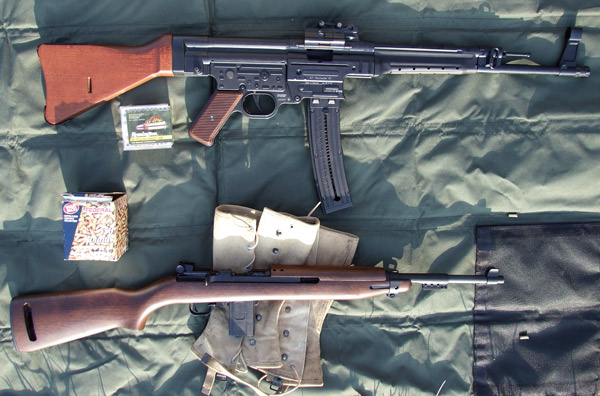

There is one big barrier in collecting World War II era firearms — the price tag. But high quality .22 replicas have made stocking your gun safe with the finest guns of the Allies and Axis accessible.
The First Assault Weapons
As currently defined, an “Assault Rifle” is considered to be a lightweight battle arm firing a cartridge of intermediate power (somewhere between a pistol cartridge and a full-blown traditional battle rifle cartridge like the .30-06) capable of being fired in a semi-automatic or full automatic mode from a high capacity detachable box magazine.
Most people consider the German StG44-Sturmgewehr 44, literally “storm (or assault) rifle, which fired the 7.92mm Kurz (short) cartridge to be the world’s first assault rifle under that definition. It was an outstanding weapon for that time, and was likely to have been at least in part, the progenitor of the Soviet AK-47.
Fortunately for the world, Adolph Hitler, besides being a psychopath, was also a micromanaging psychopath. He believed that since the M98K bolt action rifle had been good enough for him in the First World War, it was good enough for his troops 25 years later in the Seccond World War.
Development of this weapon had to be kept under wraps from him until it was perfected AND Germany was in such dire straits that a weapon of this type was needed to turn the tide of battle(s).
Fortunately again, the allies had so severely interfered with the ability of Germany to manufacture what it needed that not enough of this revolutionary arm could be produced to have much effect on the outcome of the war. But there was another assault rifle that was invented before the Stg44 that made an impact, before it was even envisioned as a weapon of this type. Our very own M1 carbine.
As many of you know, the M1 Carbine was designed originally to replace the .45 pistol as a more effective, yet easily carried weapon for rear echelon types, or specialty troops such as mortar crews. It provided much longer range accuracy and firepower than the great .45 did. But it was never intended to be fielded as a frontline.
Or was it? Well, yes and no.
There were other specialized troops that needed a weapon that was lighter and more compact than the M1 Garand or Thompson-so paratroopers were in line for the weapon-which was initially designed to have a selective fire feature. Apparently that feature was deleted by the military as being too costly, or slowing the initial development and fielding of the new weapon.
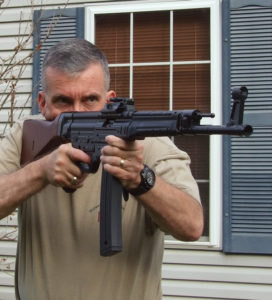
It wasn’t until the War was drawing to a close that conversion kits were provided to make the M1 Carbines in the field full auto capable, while production of the M2 select fire carbine was undertaken stateside. The late addition of select fire capability was a direct response to our encounters with the few German troops that had been equipped with the StG44.
So technically we COULD have fielded the select fire M2 carbine much earlier than we did, beating the German’s to the punch But typical stodgy military thinking may have also been involved in detouring the select fire capability as unnecessary. I say we won the race on a technicality.
We definitely won on the intermediate cartridge concept. While the .30 carbine cartridge is often thought of as a wimp of a round, it really isn’t. Launching a 110gr. bullet at over 1990 fps, and developing 967 ft. lbs. of muzzle energy-basically three times that of the 9mm at the muzzle, it is certainly nothing I would want to get hit with.
By contrast, the StG44’s 7.92×33 Kurtz, clearly the predecessor of the 7.62×39 AK47 round, launched a 125 grain bullet at 2250 fps for a muzzle energy of 1408 ft. lbs. Again, while the .30 Carbine lacks the ballistic potential of the 7.92 Kurtz, it is clearly in a ballistic class well above standard handgun cartridges. Again, the .30 Carbine qualifies as an assault rifle round, not only because of its ballistics, but because it was used as such throughout three plus Wars.
.22 caliber makeovers
The problem with both these weapons and their cartridges is that they aren’t available at reasonable cost or any cost that the average shooter can afford. Try $20,000 plus for an original StG44. Original M1’s in shootable condition are well into the $2000 range.
While there are outstanding newly manufactured M1’s available from Kahr/Auto-Ordnance, there is still the issue of ammo cost. .30 Carbine ammo is somewhat pricey. Ball ammo runs around $23 for 50 rounds. Not horrible, but not cheap.
Fortunately, the ability to have and shoot these two old war horses (or at least their stand-ins) at a very reasonable cost for both guns and ammo has arrived via two companies who are heavily invested in the burgeoning .22LR replica market. The Italian manufacturer Chiappa has given us the M1-22 .22LR M1 Carbine (sold through Century Arms and now available in a 9mm model), while Germany’s GSG (German Sport Guns) imported through American Tactical has given us the .22LR StG44. Both these guns are worth their fun, and maybe hunting and defensive weight, in gold.
The .22 replica market has been a beautiful thing.
The replicas I have worked with are often indistinguishable (without close examination by a trained eye) from the real thing. Remember the old .22LR M16 “replica” from the 1980’s? The only thing that vaguely resembled an M16 was the fact that it had a carry handle/sight and a triangular handguard. Any other resemblance To a real M16 was purely coincidental.
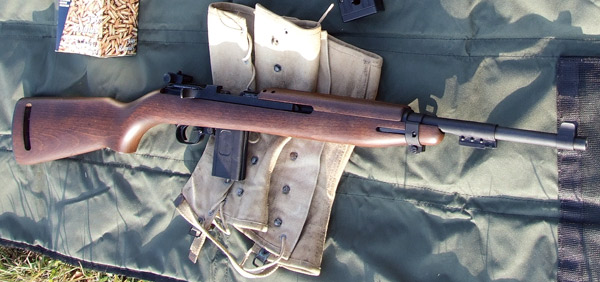
Chiappa's M1-22
All that has changed. Let’s start with a closer look at the “American” entrant.
The M1-22 is a dead ringer in the wood stock version to late war production “low wood” M1 Carbines. The stock is a very walnut appearing hardwood in a natural style low-gloss finish. The barrel and bolt are made of steel, while low stress components are polymer.
Seriously, there really is a difference between polymer and plastic-quality polymer is very durable and it works well in terms of appearance and function on the M1-22. The late war style also features a faux bayonet lug (I tried a real M1 Carbine bayonet on the gun, it didn’t fit but it looked good).
The magazine release is the correct style, and is in the correct location. The safety is the rotating lever style that replaced the original push button to avoid confusion with the magazine release button on early military M1’s. The charging handle can be locked to the rear with the small button found at the rear, just as the real M1. The bolt also stays open on the last shot.
The polymer magazine has the same profile as the original and is entirely enclosed due to its 10 round capacity limit. No loading assist button is needed. The magazine locks in place in the same manner as the original.
The rear sight is the same style as the late model adjustable carbine sight and the front sight is standard M1, plain blue-no fancy light gathering inserts. There is a slot in the stock that would accommodate an original carbine oiler and sling combo should you wish to add it, although the M1-22 is certainly no burden to carry as is.
Weight and feel is indistinguishable from the original M1 Carbine. This is about as exact a replica that could possibly be found with one exception. The receiver is grooved to accept a “tip-off” type .22 caliber scope and mount. This feature is very low profile and does not detract from the lines of the gun, but does allow the user to add a scope for hunting if they felt the need to do so and increases the versatility of the carbine. It actually took me awhile to notice it was there.
Operation, like any other semi-auto .22, is blowback, and the bolt doesn’t rotate during cycling like it does on the .30 caliber gun.
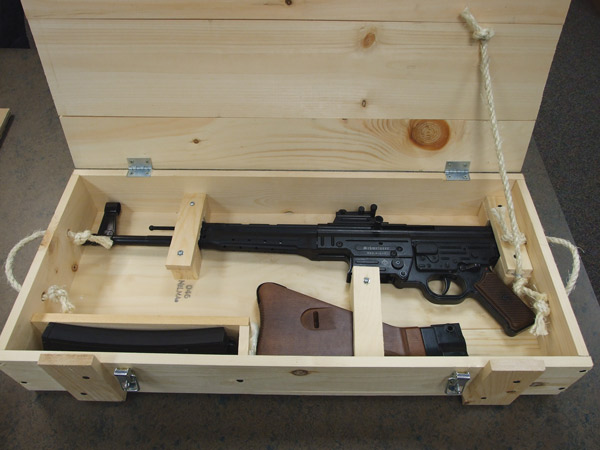
German Sport Guns' StG44
Now for the StG44 for GSG, a gun which takes the replica .22 world to even greater heights in terms of authenticity.There is no nod with this weapon to modern shooting-it is an absolute dead ringer for the original.
Now, since I have never held an original StG so my comparison is based on what I have seen in pictures, but is sure feels right, in terms of the hardwood stocks, use of metal in the construction, and the weight, which is significant compared to modern assault rifles.
The StG44 ships with one 25 round magazine, which does have a witness port down the sides. With that high a capacity, the port is needed to allow proper loading of the magazine by pushing down on the side loading levers as capacity rises. Otherwise there is too much pressure put on the relatively delicate .22 rounds as they are being stacked into the mag.
One of the most unique aspects of the StG44 is how it ships. It comes packed into a pine wood crate manufactured by Amish Craftsmen, with rope handle sides. The carbine is shipped with the wood buttstock removed in the crate which keeps the size compact. A simple captive pin system allows the stock to be mounted and kept securely in place. On the top of the box is an etched Nazi style condor, and the ATI name. The condor is a close enough style to add to the realism of the gun, but not so close as to offend.
The StG44/.22 metal portions are all finished in a matte black.There is a sling swivel at the front of the upper near the front sight,and a cut through the wood stock for rear attachment. There is no sling included, which there should be, as the StG44/.22 weighs in at substantial 8 ½ lbs, three pounds more than the Chiappa M1-22. A sling would come in handy.
Of course, the operation is blowback. The magazine port cover opens and functions much in the way that it does on the AR-15, an idea that didn’t carry over to the AK, but obviously did on the AR.
The thumb safety is on the left side, and is position like, hmm the AR15, although it operates in the opposite direction in terms of the placement of the raised thumb portion, as the Ar15. I’m beginning to think that Eugene Stoner may have borrowed as much from the original StG44 as Mikhail Kalishikov did.
The magazine release takes the form of a large checkered button on the left side of the frame directly behind the magazine well. It works positively and is best actuated with the thumb of the left hand (for right hand shooters).
The charging handle is also on the left side at the top of the receiver and can be used to lock the bolt back without the magazine in place. Below the adjustable rear sight which is adjustable for both windage and elevation. On the left side of the magazine well are the markings “Schmeisser” and “GSG-StG44”, followed by the American Tactical diamond logo.
Running the Replicas
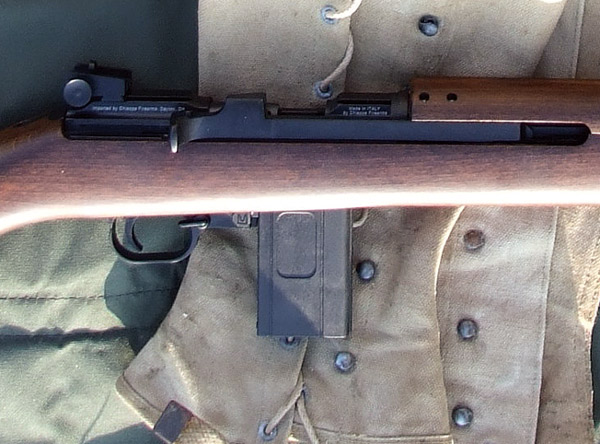
Shooting both models revealed, well, a lot of fun.
I positioned a set of targets at 70 feet in my backyard, and set about to sight in both rifles. I had two different loads on hand, some Federal bargain hi-speed 40 gr. copper coated hollowpoint loads (almost every semi-auto functions best with high velocity .22’s) that are packed loose in the 250 round box, and a 100 round package of one of my favorite .22 rounds, the Remington Yellow Jacket.
I like the both the Yellow Jacket and the similar Remington Viper. Both are semi-wadcutter in shape-the Yellow Jacket is a hollowpoint and the Viper is a solid. Both cut clean holes in paper and are likely good choices for .22 caliber self-defense. Likely due to the semi-wadcutter shape, neither rifle performed flawlessly with the Yellow Jacket, like they did with the round nose Federals. I would save the Remington’s for manual repeaters, unless your particular .22 worked well them.
I fired the guns in 5 shot strings until the end. The sights of both needed adjustment and were easily adjusted just like their original military forebears. I was firing unsupported from a seated position, at plinking speed. I was rewarded with groups from both guns and both loads in the 2- 2 ½ range size. I guarantee that some well spent, bench rested, slow fire shooting time would produce tighter results. There were no malfunctions with the Federal loads.
Triggers on both guns were quite reasonable and crisp. The Yellow Jackets produced one fail to feed in five rounds in the M1-22, and one in 10 rounds with the StG44.
After I had the sights reasonable regulated, I decided to load up the StG44 to full 25 round capacity, and let fly. All 25 went off without a hitch, and it left me thinking about what a late war German soldier felt like when armed with one of these, seeking to hold off the Soviet onslaught. It may have given him a glimmer of hope, but fortunately for the world, the StG44, like the ME262 was unleashed too late.
Rifles' Results
So, what are these two .22 replica’s of the world’s first true assault rifles good for? A heck of a lot actually. They are both an absolute hoot to shoot, especially the StG44, which, even though it’s a semi-auto .22 and not the real deal, gives a good feel as to what the real deal must be like.
Both are excellent plinkers, but the M1-.22 has the edge on prone shooting due to its shorter magazine. With a scope, the M1-.22 would be great for using on small game or as a camp gun. Both could be used for home or travel defense. No badguy who is faced by a determined citizen armed with either of these guns is going to think, “aww, that’s just a .22”. You simply could not tell in in a high stress situation. The StG44 clearly is the winner for intimidation factor between the two.
Besides thinking “oh oh” when faced with one, I am sure said badguy will also think “what the hell is that?” and leave before finding out. But the StG44 is limited in the .22 caliber roles it could play. Remember, the M1-22 is much easier to haul through the woods, or to let a small statured shooter handle. Plop a scope on it, and it should do a great job on small game, varmits and other pests. The StG44 shines best in the pure fun arena-and might make a good gun in informal .22 caliber competitive events.
I love this new .22 LR replica trend. It allows interested shooters to get their hands on guns that they either can’t afford, or that aren’t available, or to practice with a replica of the full power gun with much less expense and noise, and to have controllable guns capable of personal defense. It’s a good thing for everyone.
Gun Diest's Top Articles on .22 Ammo
- A Comprehensive Look at the Best .22LR Hangun Ammunition
- .22 Magnum vs .22 LR – Choosing the Right Rimfire Option
- A Closer Look at .22 Remington Rifles
This article originally appeared in the March 11, 2013 edition of Gun Digest the Magazine.

Next Step: Get your FREE Printable Target Pack
Enhance your shooting precision with our 62 MOA Targets, perfect for rifles and handguns. Crafted in collaboration with Storm Tactical for accuracy and versatility.
Subscribe to the Gun Digest email newsletter and get your downloadable target pack sent straight to your inbox. Stay updated with the latest firearms info in the industry.

![Best Concealed Carry Guns In 2025 [Field Tested] Wilson Combat EDC X9S 1](https://gundigest.com/wp-content/uploads/Wilson-Combat-EDC-X9S-1-324x160.jpg)


![Best 9mm Carbine: Affordable PCCs [Tested] Ruger Carbine Shooting](https://gundigest.com/wp-content/uploads/Ruger-Carbine-Shooting-100x70.jpg)
![Best AR-15: Top Options Available Today [Field Tested] Harrington and Richardson PSA XM177E2 feature](https://gundigest.com/wp-content/uploads/Harrington-and-Richardson-PSA-XM177E2-feature-100x70.jpg)

My wife purchased the STG 44 for me last Spring. I have had a blast with it. I was concerned about it shooting very low . The rear sight is replicated so closely to the original that it isn’t set up for .22 rimfires . A simple fix is to take the rear sight apart., clear down to the screw pylons on the barrel. stack 3 small washers on each pylon and reassemble the rear sight . This puts the sight adjustments into alignment and I was impressed ,as is everyone else who has fired my rifle, with it’s accuracy. Can hardly wait for the MP-40 replica to hit the shelves.
I own an STG44 and it is one of the best .22s in my safe. I also own real M1 carbines and I don’t know where you get your ammo but right now I can get .30 carbine as low as $12 for 50 rounds of FMJ compared to .22 ammo (if you can find it) for as much and in most cases even more than the .30 carbine. I also own other Chiappa .22 replicas like the 1911/22 and yes there junk. But I really do enjoy the STG44. Its one of those guns that works better as a point and shoot than actually aiming. Plus at over 8lbs NO recoil at all. Every shot follows the first. But at over 5 bills one must really want the STG.
The STG44 is a blast to shoot. Companies producing new and interesting products is what’s keeping interest going in the firearms world. Some very early ones had a fit issue with the stock. Mine is tight. I love it! Puts the fun back in shooting.
Like mostly everything else these days its a hunk of junk. The German .22 look alike assault rifle is made with a junk zinc frame as is the new Walther PP .22 pistol. Pure trash. The .22 rifle’s stock was also found to be attached in a very flimsy way which resulted In the stock wobbling when in use. What a piece of trash.
O course when one looks at .22 rifles and pistols darn few were ever made of quality. The few that were are long gone except the old Browning bottom ejecting rifle that has been around since 1900. Buy one of those if you want quality, the balance of most .22 firearms today are just pure junk.
FWIW, the Chiappa .22 LR M-1 Carbine replica was tested by the NRA, and written up in the American Rifleman some time ago, and was not highly thought of. Apparently the ignition/combustion/firing (whatever you want to call it) gasses tend to blow right back into the shooter’s face, which isn’t cool. I dunno if they do or not, that is just what the article said.